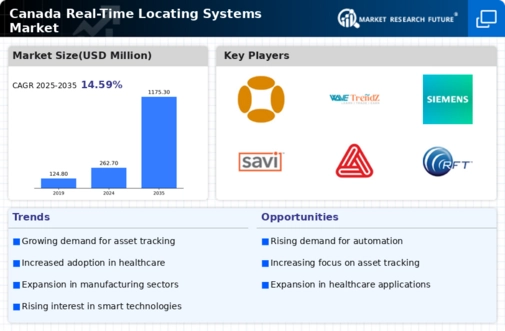Technological Advancements in RTLS
The real time-locating-systems market is experiencing a surge due to rapid technological advancements. Innovations in wireless communication technologies, such as Bluetooth Low Energy (BLE) and Ultra-Wideband (UWB), are enhancing the accuracy and efficiency of locating systems. In Canada, the integration of Internet of Things (IoT) devices with RTLS is becoming increasingly prevalent, allowing for seamless data exchange and improved tracking capabilities. This technological evolution is expected to drive market growth, with projections indicating a compound annual growth rate (CAGR) of approximately 20% over the next five years. As organizations seek to optimize operations and enhance asset management, the demand for advanced RTLS solutions is likely to escalate, positioning the industry for substantial expansion.
Increased Demand for Asset Tracking
The real time-locating-systems market is witnessing heightened demand for asset tracking solutions across various sectors. In Canada, businesses are increasingly recognizing the value of real-time visibility into their assets, which can lead to improved operational efficiency and reduced costs. Industries such as manufacturing, healthcare, and logistics are particularly focused on implementing RTLS to monitor equipment and inventory. According to recent estimates, the asset tracking segment is projected to account for over 40% of the overall market share by 2026. This growing emphasis on asset management is likely to propel the real time-locating-systems market forward, as organizations strive to minimize losses and enhance productivity.
Growing Investment in Smart Infrastructure
The real time-locating-systems market is benefiting from the growing investment in smart infrastructure across Canada. As cities and organizations prioritize the development of smart environments, the integration of RTLS technologies becomes essential for efficient resource management. Smart buildings, transportation systems, and public safety initiatives are increasingly incorporating RTLS to enhance operational efficiency and improve user experiences. The Canadian government has been actively promoting smart city initiatives, which are expected to drive demand for RTLS solutions. This investment trend suggests a promising future for the real time-locating-systems market, as stakeholders seek to leverage technology for improved urban living and operational effectiveness.
Regulatory Compliance and Safety Standards
The real time-locating-systems market is significantly influenced by the need for regulatory compliance and safety standards. In Canada, industries such as healthcare and manufacturing are subject to stringent regulations that necessitate accurate tracking of assets and personnel. RTLS solutions provide a means to ensure compliance with safety protocols, thereby reducing liability risks. The increasing focus on workplace safety and operational transparency is driving organizations to adopt RTLS technologies. As a result, the market is expected to grow, with compliance-related applications potentially accounting for a substantial portion of the overall demand. This trend indicates a strong alignment between regulatory requirements and the capabilities offered by real time-locating-systems.
Rising Need for Enhanced Operational Efficiency
The real time-locating-systems market is propelled by the rising need for enhanced operational efficiency among organizations. In Canada, businesses are under constant pressure to optimize processes and reduce operational costs. RTLS technologies offer solutions that enable real-time monitoring of assets, personnel, and workflows, leading to improved decision-making and resource allocation. Industries such as retail, healthcare, and logistics are particularly focused on leveraging RTLS to streamline operations. Market analysis indicates that organizations implementing RTLS can achieve efficiency gains of up to 30%, making it a compelling investment. This growing emphasis on operational excellence is likely to sustain the momentum of the real time-locating-systems market in the coming years.





















Leave a Comment